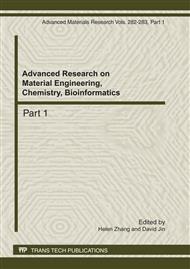p.231
p.236
p.240
p.244
p.248
p.253
p.257
p.261
p.267
Genetic Regulatory Network Analysis for Rpe65 in the Eye of BXD Mice
Abstract:
Previous studies have revealed that the mutation of Rpe65 plays a critical role in inherited retinal dystrophies. However, little is known about the genetic regulatory network for Rpe65 and inherited retinal dystrophies. We combined gene expression microarray analysis and quantitative trait loci (QTL) mapping to characterize the genetic regulatory network for Rpe65 expression in the eye of BXD recombinant inbred (RI) mice. Our analysis found that the expression level of Rpe65 exhibited much variation in the eye across the BXD RI strains and between the parental strains, C57BL/6J and DBA/2J. Expression QTL (eQTL) mapping showed that one microarray probe set of Rpe65 has highly significant linkage (Likelihood Ratio Statistic) scores. Moreover, the QTL was mapped to within 3 Mb of the location of the gene itself (Rpe65) as a cis-acting QTL. Through mapping the joint modulation of Rpe65, we identified Ches1/Foxn3 as downstream gene of Rpe65. Then the gene co-regulatory network analysis was constructed. The genetic genomics approach demonstrates the importance and the potential power of the eQTL studies in identifying genetic regulatory networks that contribute to inherited retinal dystrophies.
Info:
Periodical:
Pages:
248-252
Citation:
Online since:
July 2011
Authors:
Price:
Сopyright:
© 2011 Trans Tech Publications Ltd. All Rights Reserved
Share:
Citation:


